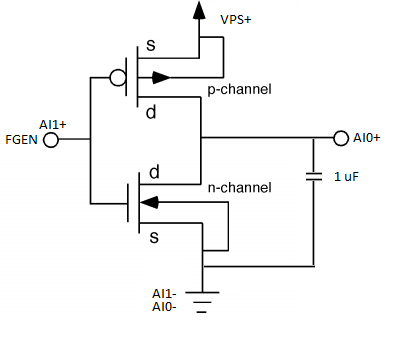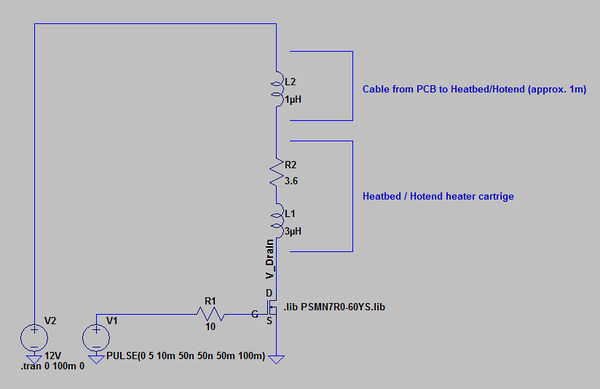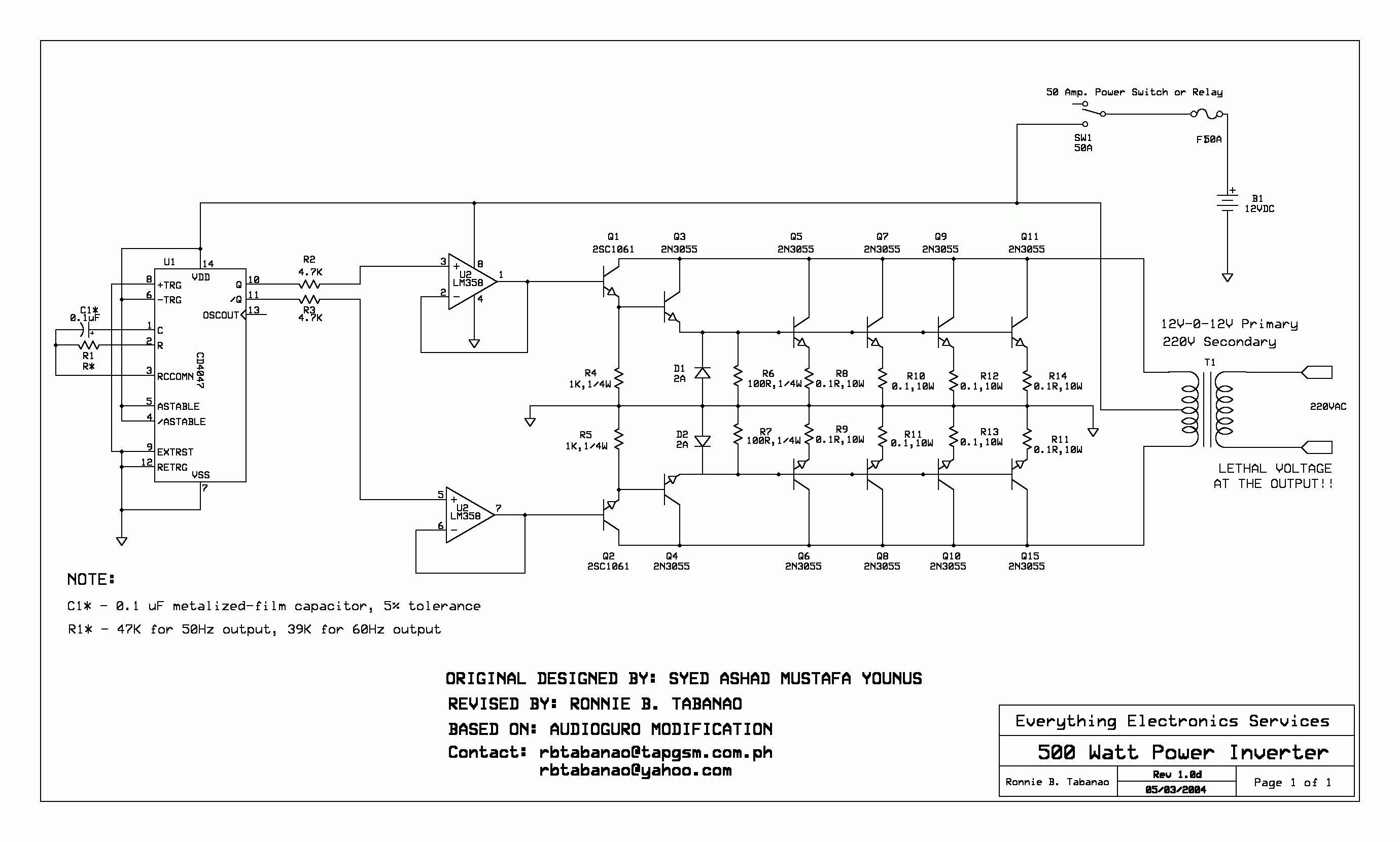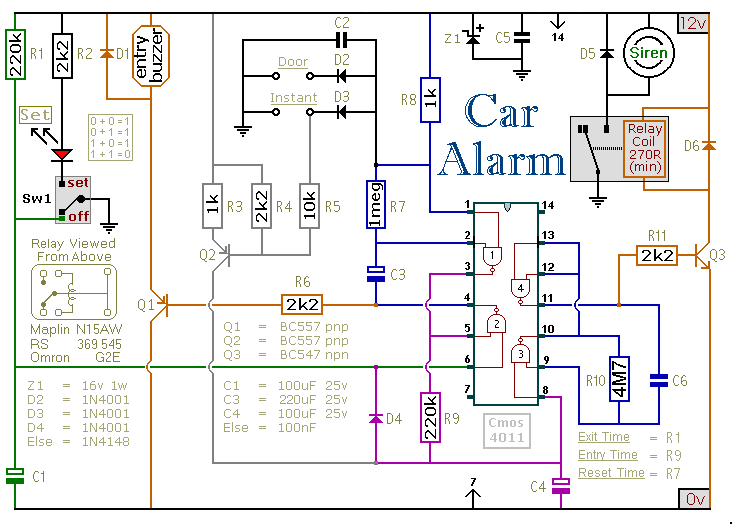
MOSFETs and CMOS Inverter

Using measured threshold voltage and Ids-Vds curves, the performance of first-order MOSFET theory can be evaluated in real devices, allowing for an understanding of the limitations of first-order theoretical MOSFET equations. The MOSFETs employed in this experiment are from the ALD1105 integrated circuit, which contains two n-MOSFETs and two p-MOSFETs. A circuit symbol description of the two pairs of transistors is illustrated in figure 1. Each transistor features four terminals: drain (D), source (S), gate (G), and substrate, referred to as body (B) in this context. As discussed in class, all n-MOSFETs within an integrated circuit share a common p-type body, which must be connected to the lowest voltage in the system to maintain zero or reverse bias across all source/drain to body PN junctions. Conversely, all p-MOSFETs share a common n-type body, which should be connected to the highest voltage in the system for the same reason. A MOSFET functions as a natural voltage-controlled switch, as depicted in figure 3. A high gate voltage activates the MOSFET channel, permitting current to flow between the drain and source, thus powering a load such as an LED, speaker, or fan. The current provided by the MOSFET is influenced by physical properties of the transistor, including width, length, oxide thickness, gate voltage, and load. A CMOS inverter will be constructed to demonstrate the proper power supply and input voltage waveforms necessary for testing its basic functionality. For a given supply voltage (VDD), the low voltage should be zero, while the high voltage should correspond to VDD. The function generator typically outputs a signal that varies from -VPP/2 to +VPP/2, where VPP represents the peak-to-peak voltage. For a square wave, the low voltage is -VPP/2 and the high voltage is +VPP/2. To set the low voltage to zero, the DC offset can be adjusted to VPP/2. The datasheet should be consulted to determine the threshold voltage range, maximum continuous drain current (ID), maximum drain-source voltage, and maximum permissible power dissipation (Ptot). Input waveforms required to test the CMOS inverter's functionality should be sketched for supply voltages of 3V, 5V, and 7V. The VPP and DC offset settings for the function generator must also be calculated. According to the datasheet, the threshold voltage is defined as the value of Vgs when ID equals 1 µA while the transistor is biased in saturation, denoted as Vgs(th) in the datasheet and Vtn in this text. To force a transistor into saturation, the drain and gate can be connected, allowing for the measurement of the I-V curve of this diode-like circuit using a 2-wire analyzer. The threshold voltage can be assessed from the voltage at which the current reaches a predetermined threshold. In the 2-wire SFP, selecting the Cursor On option enables the observation of current and voltage values at specific points. The voltage value corresponding to Id = 1 µA should be checked to determine if the value of Vtn falls within the specified range on the datasheet. Screenshots illustrate that significant figures may be lost on the y-axis due to very small current readings, which results from the ELVIS II unit measuring accurate values but being unable to display values below a certain threshold on the y-axis.
The evaluation of the first-order MOSFET theory through practical application involves a systematic approach to understanding the operational characteristics of n-MOSFETs and p-MOSFETs in the ALD1105 IC. The four-terminal configuration of the transistors allows for comprehensive analysis of their electrical behavior under different biasing conditions. The shared body configuration of the n-MOSFETs and p-MOSFETs necessitates careful attention to voltage levels to prevent undesired conduction through the body diode, which can compromise device performance.
The construction of the CMOS inverter serves as a practical application of MOSFET theory, enabling the demonstration of voltage-controlled switching. The function generator's output settings play a crucial role in ensuring that the inverter operates correctly, with specific attention to the DC offset and peak-to-peak voltage. The determination of threshold voltage, maximum drain current, and other critical parameters from the datasheet is essential for predicting the inverter's behavior under various operating conditions.
The process of measuring the I-V characteristics using a 2-wire analyzer provides valuable insights into the transistor's performance, particularly in identifying the threshold voltage where the device transitions from the off state to the on state. This measurement is vital for verifying the specifications outlined in the datasheet and ensuring that the transistors function as intended in the circuit. The careful analysis of current readings, especially at low levels, highlights the limitations of measurement equipment and the importance of accurate data interpretation in the context of semiconductor device characterization.Using measured threshold voltage and Ids-Vds curves, we can then check how well first-order MOSFET theory holds up in real devices and get a practical feel of the limitation of first-order theoretical MOSFET equation. The MOSFETs we will use in this experiment are from ALD1105, an IC containing two n-MOSFETs and two p-MOSFETs.
A circuit symbol des cription of the two pairs of transistors from the data sheet is shown below in figure 1. Note each transistor has four terminals: drain (D), source (S), gate (G), and substrate, which is called body (B) in our text. As we learned in class, all the n-MOSFETs on an IC share the same p-type body, which needs to be tied to the lowest voltage in a system to keep all the source/drain to body PN junctions zero or reverse biased.
Similarly, all the p-MOSFETs on an IC share the same n-type body, which needs to be tied to the highest voltage in a system to keep all the source/drain to body PN junctions zero or reverse biased. A MOSFET is a natural voltage-controlled switch, as illustrated in figure 3. A high gate voltage turns on the MOSFET channel, allowing current to flow between drain and source, thereby turning a load, which can be a LED, a speaker or a fan.
The amount of current the MOSFET can provide depends on the transistor physical properties such as width, length, oxide thickness, etc. , the gate voltage, and the load. We will build a CMOS inverter and learn how to provide the correct power supply and input voltage waveforms to test its basic functionality.
For a given supply VDD, your voltage low should be zero, and voltage high should be VDD. By default, the function generator gives an output that varies from -VPP/2 to +VPP/2, with VPP being peak-to-peak voltage. For a square wave, the voltage low is -VPP/2, voltage high is +VPP/2. You can set the DC offset to VPP/2 to make voltage low 0. Using the datasheet, determine the values of the threshold voltage range, the maximum continuous drain current ID, the maximum drain-source voltage, and the maximum allowed power dissipation, Ptot.
For a VDD of 3V, 5V, 7V, sketch the input waveforms required to test the functionality of the CMOS inverter. Determine the VPP and dc offset setting required for function generator. On the data sheet, the threshold voltage is defined to be the value of Vgs when ID = 1 uA when the transistor is biased at saturation.
The data sheet uses the notation Vgs(th) for the threshold voltage, whereas our text uses the notation Vtn. We can force a transistor to work in saturation by connecting the drain and gate. We can then measure the I-V curve of this diode-like circuit using the 2-wire analyzer. The threshold voltage can then be determined from the voltage at which current equals a set threshold.
In the 2-wire SFP select the Cursor On box. This will allow you to see the current and voltage values at specific points. Using this check the voltage value at the point where Id = 1uA. Does your value of Vtn fall within the range specified on the data sheet As you can see from the screen shots provided below, some significant figures are lost on the y-axis as very small current readings are measured. This is the result of the ELVIS II unit measuring correct values but the y-axis being unable to display below a certain threshold.
🔗 External reference
The evaluation of the first-order MOSFET theory through practical application involves a systematic approach to understanding the operational characteristics of n-MOSFETs and p-MOSFETs in the ALD1105 IC. The four-terminal configuration of the transistors allows for comprehensive analysis of their electrical behavior under different biasing conditions. The shared body configuration of the n-MOSFETs and p-MOSFETs necessitates careful attention to voltage levels to prevent undesired conduction through the body diode, which can compromise device performance.
The construction of the CMOS inverter serves as a practical application of MOSFET theory, enabling the demonstration of voltage-controlled switching. The function generator's output settings play a crucial role in ensuring that the inverter operates correctly, with specific attention to the DC offset and peak-to-peak voltage. The determination of threshold voltage, maximum drain current, and other critical parameters from the datasheet is essential for predicting the inverter's behavior under various operating conditions.
The process of measuring the I-V characteristics using a 2-wire analyzer provides valuable insights into the transistor's performance, particularly in identifying the threshold voltage where the device transitions from the off state to the on state. This measurement is vital for verifying the specifications outlined in the datasheet and ensuring that the transistors function as intended in the circuit. The careful analysis of current readings, especially at low levels, highlights the limitations of measurement equipment and the importance of accurate data interpretation in the context of semiconductor device characterization.Using measured threshold voltage and Ids-Vds curves, we can then check how well first-order MOSFET theory holds up in real devices and get a practical feel of the limitation of first-order theoretical MOSFET equation. The MOSFETs we will use in this experiment are from ALD1105, an IC containing two n-MOSFETs and two p-MOSFETs.
A circuit symbol des cription of the two pairs of transistors from the data sheet is shown below in figure 1. Note each transistor has four terminals: drain (D), source (S), gate (G), and substrate, which is called body (B) in our text. As we learned in class, all the n-MOSFETs on an IC share the same p-type body, which needs to be tied to the lowest voltage in a system to keep all the source/drain to body PN junctions zero or reverse biased.
Similarly, all the p-MOSFETs on an IC share the same n-type body, which needs to be tied to the highest voltage in a system to keep all the source/drain to body PN junctions zero or reverse biased. A MOSFET is a natural voltage-controlled switch, as illustrated in figure 3. A high gate voltage turns on the MOSFET channel, allowing current to flow between drain and source, thereby turning a load, which can be a LED, a speaker or a fan.
The amount of current the MOSFET can provide depends on the transistor physical properties such as width, length, oxide thickness, etc. , the gate voltage, and the load. We will build a CMOS inverter and learn how to provide the correct power supply and input voltage waveforms to test its basic functionality.
For a given supply VDD, your voltage low should be zero, and voltage high should be VDD. By default, the function generator gives an output that varies from -VPP/2 to +VPP/2, with VPP being peak-to-peak voltage. For a square wave, the voltage low is -VPP/2, voltage high is +VPP/2. You can set the DC offset to VPP/2 to make voltage low 0. Using the datasheet, determine the values of the threshold voltage range, the maximum continuous drain current ID, the maximum drain-source voltage, and the maximum allowed power dissipation, Ptot.
For a VDD of 3V, 5V, 7V, sketch the input waveforms required to test the functionality of the CMOS inverter. Determine the VPP and dc offset setting required for function generator. On the data sheet, the threshold voltage is defined to be the value of Vgs when ID = 1 uA when the transistor is biased at saturation.
The data sheet uses the notation Vgs(th) for the threshold voltage, whereas our text uses the notation Vtn. We can force a transistor to work in saturation by connecting the drain and gate. We can then measure the I-V curve of this diode-like circuit using the 2-wire analyzer. The threshold voltage can then be determined from the voltage at which current equals a set threshold.
In the 2-wire SFP select the Cursor On box. This will allow you to see the current and voltage values at specific points. Using this check the voltage value at the point where Id = 1uA. Does your value of Vtn fall within the range specified on the data sheet As you can see from the screen shots provided below, some significant figures are lost on the y-axis as very small current readings are measured. This is the result of the ELVIS II unit measuring correct values but the y-axis being unable to display below a certain threshold.
🔗 External reference





